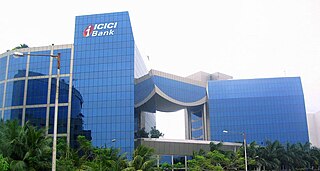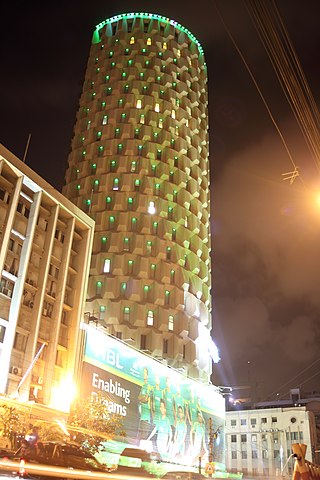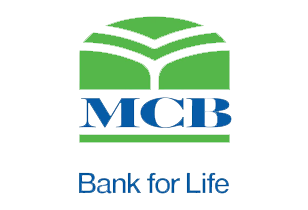Related Research Articles

A central bank, reserve bank, national bank, or monetary authority is an institution that manages the currency and monetary policy of a country or monetary union. In contrast to a commercial bank, a central bank possesses a monopoly on increasing the monetary base. Many central banks also have supervisory or regulatory powers to ensure the stability of commercial banks in their jurisdiction, to prevent bank runs, and in some cases also to enforce policies on financial consumer protection and against bank fraud, money laundering, or terrorism financing.

The economy of Yemen has significantly weakened since the breakout of the Yemeni Civil War and the humanitarian crisis, which has caused instability, escalating hostilities, and flooding in the region. At the time of unification, South Yemen and North Yemen had vastly different but equally struggling underdeveloped economic systems. Since unification, the economy has been forced to sustain the consequences of Yemen's support for Iraq during the 1990–91 Persian Gulf War: Saudi Arabia expelled almost 1 million Yemeni workers, and both Saudi Arabia and Kuwait significantly reduced economic aid to Yemen. The 1994 civil war further drained Yemen's economy. As a consequence, Yemen has relied heavily on aid from multilateral agencies to sustain its economy for the past 24 years. In return, it has pledged to implement significant economic reforms. In 1997 the International Monetary Fund (IMF) approved two programs to increase Yemen's credit significantly: the enhanced structural adjustment facility and the extended funding facility (EFF). In the ensuing years, Yemen's government attempted to implement recommended reforms: reducing the civil service payroll, eliminating diesel and other subsidies, lowering defense spending, introducing a general sales tax, and privatizing state-run industries. However, limited progress led the IMF to suspend funding between 1999 and 2001.

The Reserve Bank of India, abbreviated as RBI, is India's central bank and regulatory body responsible for regulation of the Indian banking system. Owned by the Ministry of Finance, Government of India, it is responsible for the control, issue and maintaining supply of the Indian rupee. It also manages the country's main payment systems and works to promote its economic development. Bharatiya Reserve Bank Note Mudran (BRBNM) is a specialised division of RBI through which it prints and mints Indian currency notes (INR) in two of its currency printing presses located in Mysore and Salboni. The RBI, along with the Indian Banks' Association, established the National Payments Corporation of India to promote and regulate the payment and settlement systems in India. Deposit Insurance and Credit Guarantee Corporation was established by RBI as one of its specialized division for the purpose of providing insurance of deposits and guaranteeing of credit facilities to all Indian banks.

ICICI Bank Limited is an Indian multinational bank and financial services company headquartered in Mumbai with a registered office in Vadodara. It offers a wide range of banking and financial services for corporate and retail customers through various delivery channels and specialized subsidiaries in the areas of investment banking, life, non-life insurance, venture capital and asset management.

The savings and loan crisis of the 1980s and 1990s was the failure of 32% of savings and loan associations (S&Ls) in the United States from 1986 to 1995. An S&L or "thrift" is a financial institution that accepts savings deposits and makes mortgage, car and other personal loans to individual members.

The State Bank of Pakistan (SBP) is the Central Bank of Pakistan. Its Constitution, as originally laid down in the State Bank of Pakistan Order 1948, remained basically unchanged until 1 January 1974, when the bank was nationalised and the scope of its functions was considerably enlarged. The State Bank of Pakistan Act 1956, with subsequent amendments, forms the basis of its operations today. The headquarters are located in the financial capital of the country in Karachi. The bank has a fully owned subsidiary with the name SBP Banking Services Corporation (SBP-BSC), the operational arm of the Central Bank with Branch Office in 16 cities across Pakistan, including the capital Islamabad and the four provincial capitals Lahore, Karachi, Peshawar, Quetta. The State Bank of Pakistan has other fully owned subsidiaries as well: National Institute of Banking and Finance, the training arm of the bank providing training to Commercial Banks, the Deposit Protection Corporation, and ownership of the Pakistan Security Printing Corporation.

Bangladesh Bank is the central bank of Bangladesh and is a member of the Asian Clearing Union. It is fully owned by the Government of Bangladesh.

National Bank of Pakistan, abbreviated as NBP is a Pakistani government-owned multinational commercial bank which is a subsidiary of State Bank of Pakistan. It is headquartered in Karachi, Pakistan. As of December 2022, it has over 1,500 branches across Pakistan.

BankIslami Pakistan LTD. is a Pakistani Islamic bank based in Karachi, Pakistan. It has 400+ branches in 150 cities in Pakistan. It is the first Islamic commercial bank to receive the Islamic banking license under the Islamic banking policy of 2003 from the State Bank of Pakistan on March 31, 2005. The bank started its operations on 7 April 2006 and offers shariah-compliant retail banking, investment banking, consumer banking, and trade finance products. The bank intends to focus on wealth management as the core area of business and plans to soon launch proprietary products and integrated financial planning services. The bank has a nationwide presence. With the amalgamation of KASB on May 7, 2015, all 104 branches of KASB have become part of BankIslami’s branch network. BankIslami is now the 11th largest banking network in the country. The idea of BankIslami was conceptualized by Jahangir Siddiqui & Company Limited and Randeree family in late 2003. Mr. Hasan A. Bilgram I. was appointed as adviser to the sponsors on 16 March 2004 to formalize the idea. He presented the concept paper of BankIslami to sponsors on 24 March 2004. A detailed business plan was then prepared and a formal application was submitted to the State Bank of Pakistan on 26 May 2004. On the 26th of September 2005, Dubai Bank joined the sponsors and became one of the founding shareholders of BankIslami by investing 18.75% in the total capital.
The National Bank of Ethiopia is the central bank of Ethiopia. Its headquarters are in the capital city of Addis Ababa. Mamo Mihretu is the current governor of the bank.

Habib Bank Limited abbreviated as HBL, is a Pakistani multinational bank based at Habib Bank Plaza, Karachi, Pakistan.

MCB Bank Limited is a Pakistani multinational commercial bank which is based in Lahore, Punjab, Pakistan. The majority of shares are owned by Pakistani conglomerate Nishat Group and Malaysian bank Maybank. The bank has a network of 1600 branches and over 1450 ATMs in Pakistan. The current President/CEO of the bank is Shoaib Mumtaz.
China's banking sector had CN¥319.7 trillion in assets at the end of 2020. The "Big Four" state-owned commercial banks are the Bank of China, the China Construction Bank, the Industrial and Commercial Bank of China, and the Agricultural Bank of China, all of which are among the largest banks in the world As of 2018. Other notable big and also the largest banks in the world are China Merchants Bank and Ping An Bank.

Following the Iranian Revolution, Iran's banking system was transformed to be run on an Islamic interest-free basis. As of 2010 there were seven large government-run commercial banks. As of March 2014, Iran's banking assets made up over a third of the estimated total of Islamic banking assets globally. They totaled 17,344 trillion rials, or US$523 billion at the free market exchange rate, using central bank data, according to Reuters.
Bangladesh is a developing country with an impoverished banking system, particularly in terms of the services and customer care provided by the government run banks. In recent times, private banks are trying to imitate the banking structure of the more developed countries, but this attempt is often foiled by inexpert or politically motivated government policies executed by the central bank of Bangladesh, Bangladesh Bank. The outcome is a banking system fostering corruption and illegal monetary activities/laundering etc. by the politically powerful and criminals, while at the same time making the attainment of services or the performance of international transactions difficult for the ordinary citizens, students studying abroad or through distance learning, general customers etc.
Before Uganda's independence in 1962, the main banks in Uganda were Barclays ; Grindlays, Standard Bank and the Bank of Baroda from India. The currency was issued by the East African Currency Board, a London-based body. In 1966, the Bank of Uganda (BoU), which controlled the issue of currency and managed foreign exchange reserves, became the central bank and national banking regulator. The government-owned Uganda Commercial Bank and the Uganda Development Bank were launched in the 1960s. The Uganda Development Bank is a state-owned development finance institution, which channeled loans from international sources into Ugandan enterprises and administered most of the development loans made to Uganda.

The economic policies proposed under the banner of "Islamisation" in Pakistan include executive decrees on Zakāt (poor-due), Ushr (tithe), judicial changes that helped to halt land redistribution to the poor, and perhaps most importantly, elimination of riba. Perhaps the foremost exponent of Islamisation among Pakistan's rulers—General Muhammad Zia-ul-Haq—advanced a programme in 1978 to bring Pakistan law in line with the principles of Sharia law.
Banking in Sudan covers the history, development and structure of banking in the Sudan. From the inheritance of the banking system from the Anglo-Egyptian Sudan to the establishment of the Sudan central bank in 1959 and development of Islamic banking in the mid 1970s.

Banking in Turkey is an important aspect of the financial system Turkey's dynamic economy. Banks handle the majority of money and capital market transactions and activity. Commercial banks make up the majority of Turkey's financial sector, accounting for 91 percent of overall financial sector assets as of 2020.

The banking sector of Ethiopia composed of the central bank, the National Bank of Ethiopia (NBE), which is state owned and sixteen private banks. By 2020, the NBE planned to increase the minimum capital for banks to operate to 2 billion birr and instructed all commercial banks to increase their capital. Foreign banks did not allow to provide service in Ethiopia, instead use medium term as the government of Prime Minister Abiy Ahmed pursues wide economic reforms.